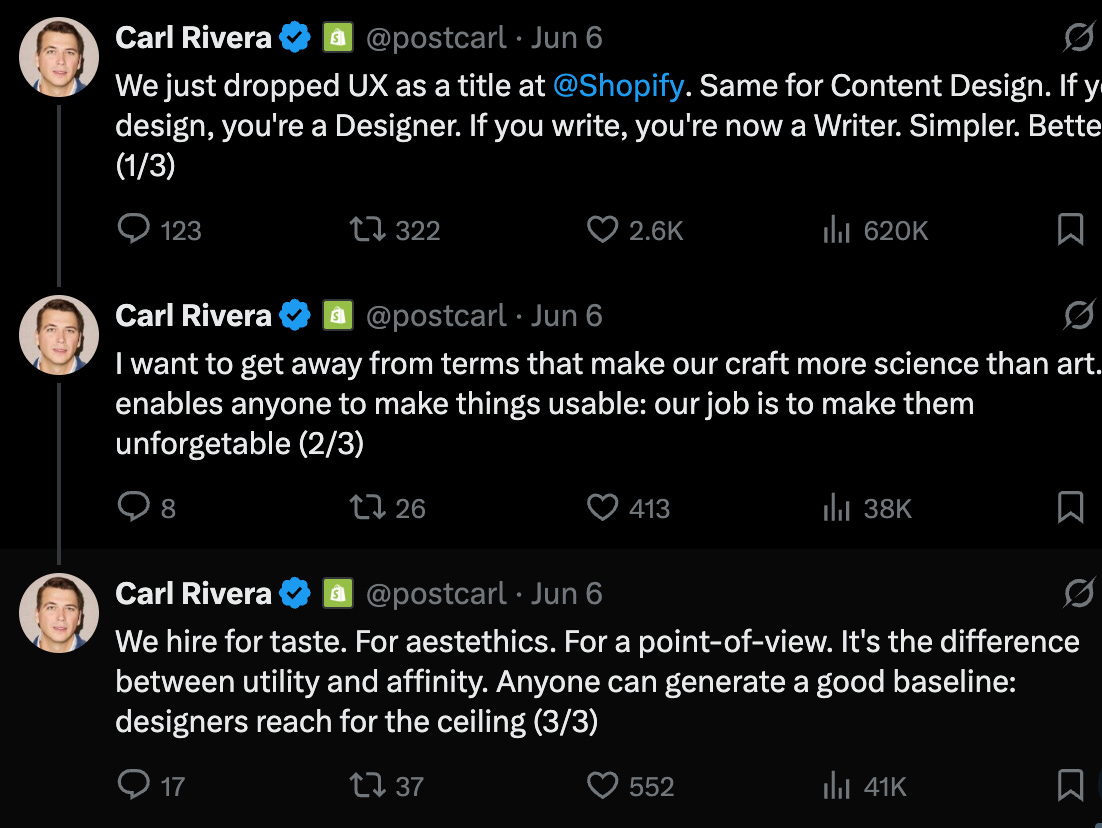Full-stack Design is a Myth: How Flattening Roles Undermines Outcomes
#003: Shopify’s decision to drop UX and Content titles is part of a broader industry trend and it’s costing companies more than they realize.
Last week Shopify announced it had dropped “UX” and “Content” from its design job titles. “If you design, you're a Designer. If you write, you're a Writer,” said Chief Design Officer Carl Rivera on Twitter/X. It’s positioned as a simplification and a move to reflect modern creative work and its intersection with AI.

At first glance, this might seem like harmless semantics. But it marks a troubling trend: the flattening of specialized design roles into increasingly generic, catch-all titles like “Product Designer” or now simply “Designer.” While this may streamline org charts, it’s not just semantically risky — it actively undermines the quality of outcomes, the growth of design talent, and the credibility of design as a profession.
Would Shopify — or any serious company — apply the same logic to engineering? Are all developers just “Developers”? No distinction between Android and iOS, between front-end, back-end, infrastructure, QA, or data? Could a web developer with passing familiarity with SwiftUI build a native iOS app? Technically, sure. But would it be robust, elegant, and performant?
Highly unlikely. And only a specialist would know what was missed.
Design, Devalued by Familiarity
Unlike engineering, design is visible. Everyone can sketch a box on a screen. Everyone can suggest a tweak to a font, color, or margin. This accessibility is part of design’s power — but also its curse. Because everyone can participate, many assume they understand the full depth of the craft.
That’s why the title “Designer” is so easily flattened. It feels understandable. But when that single word is expected to encompass user research, content design, information architecture, interaction design, visual design, accessibility, prototyping, facilitation, and storytelling — what we gain in simplicity, we lose in clarity and capability.
The result? Work gets done, but often not as well as it could have been. And few outside of Design know the difference.
The Real Cost of Role Collapse
A generalist Designer may understand when a project demands something outside their depth — like generative research or systems-level content strategy. But their peers may not. As long as the product ships and the interface functions, it passes inspection.
But that’s the trap: design failure doesn’t always look like failure. It looks like a product that works but doesn’t convert as highly as it otherwise would. That users try and then abandon. That meets the brief, but misses the mark.
This trend didn’t start with Shopify. It’s the legacy of the agile-then-digital transformation consulting-industrial complex, which bundled design into hyper-efficient delivery teams and collapsed its practices into the now-ubiquitous “Product Designer” role. Content designers, researchers, and accessibility advocates were folded in or simply left out.
It mirrors the “full-stack developer” boom of the early 2010s. That promise faded fast. Few developers truly excel at both ends of the stack, and the work suffered. Interfaces were clunky. Back ends were brittle. Eventually, teams learned: just because you can combine roles doesn’t mean you should.
Design hasn’t had that reckoning yet, but it needs to.
Flattened Roles, Lower Ceilings
When companies flatten design titles, they don’t just simplify — they shrink what their teams can achieve. They lower the ceiling for creativity, quality, and business outcomes.
Shopify claims AI is part of the reason for this shift. But the irony is sharp: the design skills most resilient to automation, including research, facilitation, behavioral insight, and strategic synthesis, are the very ones being erased from the org chart. You can prompt ChatGPT to generate interface copy, but it can’t navigate a difficult stakeholder conversation or decode what a user isn’t saying in an interview.
A Way Forward
If companies want better outcomes, they must treat design like the strategic function it is. That starts with:
Auditing your teams. What specialized skills do your designers actually bring? What gaps are being papered over?
Fixing your operating model. Instead of embedding one generalist per squad, enable flexible assignment based on the skills the problem demands — just as you would with engineering.
Restoring craft-specific titles. Not for ego, but for clarity, growth, and impact.
Flattening design doesn’t just devalue the discipline. It devalues the product. It accepts “good enough” when “great” was possible.
Design isn't a single discipline. It’s a system of interdependent specialties. The best companies know the difference and structure their teams accordingly.



